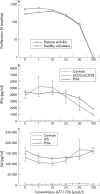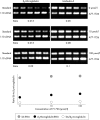Differential effects of leflunomide and methotrexate on cytokine production in rheumatoid arthritis
- PMID: 15115713
- PMCID: PMC1755136
- DOI: 10.1136/ard.2003.014738
Differential effects of leflunomide and methotrexate on cytokine production in rheumatoid arthritis
Abstract
Background: T cells have a pivotal role in RA. Leflunomide inhibits pyrimidine biosynthesis, to which T cells are especially susceptible, and therefore may have a different cytokine profile than methotrexate.
Materials and methods: Serum samples of 100 patients with RA, treated with leflunomide (n = 50) or methotrexate (n = 50), were collected at baseline, after 16 weeks and after 1 year's treatment. Serum levels of interleukin 6 (IL6), and interferon (IFN) gamma were determined by ELISA. Additionally, peripheral blood mononuclear cells (PBMC) of five healthy volunteers and three patients with RA were isolated and the effects of the active metabolite of leflunomide (A77-1726, 0-200 mmol/l) on cell proliferation and on IL6 and IFNgamma production were determined by ELISA. In peripheral blood lymphocytes (PBL) and monocytes (PBM) from two healthy volunteers the effects of A77-1726 on IL6 production were measured by ELISA and PCR.
Results: Mean (SEM) serum levels of IFNgamma were significantly reduced after leflunomide treatment (baseline 43 (10) pg/ml; 1 year 29 (7) (p = 0.015), but there was no change in IL6 levels (baseline 158 (41), 1 year 151 (48)). Both IFNgamma and IL6 levels were significantly reduced after methotrexate treatment. This observation was supported by in vitro experiments. The production of IFNgamma by PBL was inhibited by A77-1726, but IL6 production by PBM was not inhibited.
Conclusion: The differential effect on IFNgamma and IL6 production supports the hypothesis that activated T cells are preferentially inhibited by leflunomide. An explanation may be either inhibition of uridine synthesis or effects on signal transduction pathways.
Figures


References
Publication types
MeSH terms
Substances
LinkOut - more resources
Full Text Sources
Other Literature Sources
Medical

